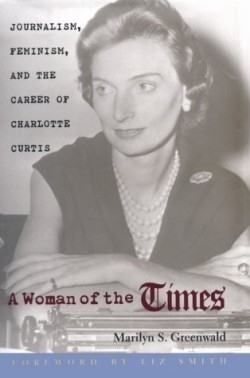A Woman of the Times
Journalism Feminism and the Career of Charlotte Curtis
In 1974, female employees of the New York Times were preparing a class-action gender discrimination lawsuit against their employer when the Times promoted society editor Charlotte Curtis, who was not among the plaintiffs, to head the prestigious op-ed page. This appointment made Curtis the first woman to be listed on the paper’s masthead and blazed the trail that women such as Anna Quindlen and Maureen Dowd would follow.
Greenwald draws no connection between the lawsuit and Curtis’ appointment, attributing the promotion to hard work, talent, political savvy and friends in high places. Although Curtis’ ambiguous role in the feminist movement of the 1960s and 70s is discussed, Greenwald’s focus is on the means and motivations that brought Curtis, a daughter of a prominent and affluent Ohio family, to the pinnacle of journalism.
As Greenwald notes, most women in Curtis’ social class did not seek careers outside the home in the 1950s, and certainly not newspaper jobs, which at the time were, as Curtis herself put it, jobs “for itinerants, for cab drivers, for railroad engineers.” But Curtis did not come from a family that expected her to be content with Junior League bake sales and society luncheons. Her mother, Lucile Atcherson, was a suffrage leader and the first woman in the U.S. Foreign Service, and her father, George Curtis, was a prominent medical researcher and surgeon. The couple instilled in their two daughters an ethic of hard work, public service and progressive politics. So it shocked no one who knew her that Charlotte chose to spend her summer vacations from Vassar as an intern at the Columbus Citizen, where, even after graduation, she was delegated to the society and women’s pages. After ten years, she left for the women’s pages of the Times, but with her eye on the news section.
Greenwald paints a portrait of a woman whose breeding, manners and taste enabled her to blend effortlessly with the Times’ ruling aristocracy and the wealthy subjects she often skewered in print. She was a woman who had a passionate commitment to the civil rights movement but largely shunned and even ridiculed the feminists. She was a woman who avoided personal confrontations but often rocked the boat with Times’ management. Her loyalty and devotion to the Times was so intense that one insider called her “the bride of the New York Times,” yet she ruffled a few feathers by giving “aid and comfort” to critics of the paper. She was known for her unshakable professional morals, including her pioneering “all brides are not beautiful” statement that forced truth in journalism even into the society pages. But she twice had affairs with married men (the latter whom she married, happily, in 1972) and scandalized her family and Columbus society in 1953 by divorcing her husband of three years.
The story of this fascinating and remarkable woman is an excellent work to read for feminists, journalists and anyone who enjoys a good biography. Curtis died of cancer in 1987 at the age of fifty-eight. It is a pity that the writer who was rebuked by Times management for violating the paper’s standards of taste and tenor by printing a story that alluded to the homosexuality of an Austrian princess’ bridegroom did not live to read the Starr Report.
Reviewed by
Sharon Flesher
Disclosure: This article is not an endorsement, but a review. The publisher of this book provided free copies of the book to have their book reviewed by a professional reviewer. No fee was paid by the publisher for this review. Foreword Reviews only recommends books that we love. Foreword Magazine, Inc. is disclosing this in accordance with the Federal Trade Commission’s 16 CFR, Part 255.

